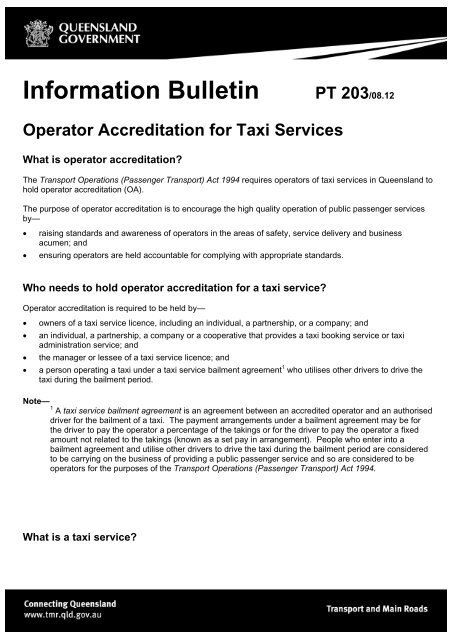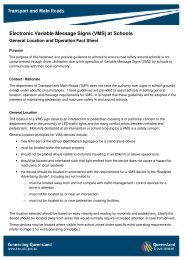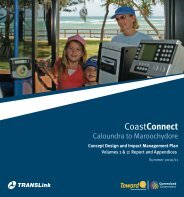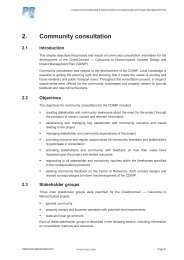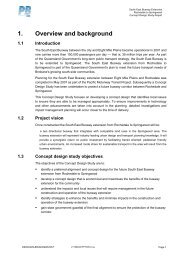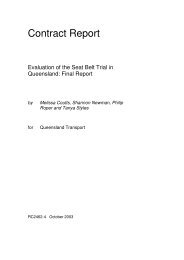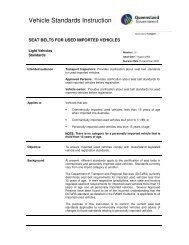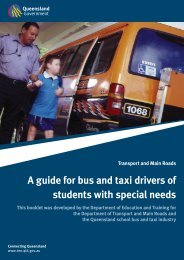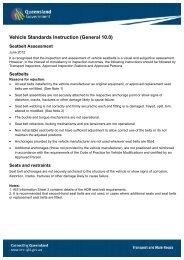Operator Accreditation for Taxi Services - Department of Transport ...
Operator Accreditation for Taxi Services - Department of Transport ...
Operator Accreditation for Taxi Services - Department of Transport ...
Create successful ePaper yourself
Turn your PDF publications into a flip-book with our unique Google optimized e-Paper software.
In<strong>for</strong>mation Bulletin PT 203/08.12<br />
<strong>Operator</strong> <strong>Accreditation</strong> <strong>for</strong> <strong>Taxi</strong> <strong>Services</strong><br />
What is operator accreditation?<br />
The <strong>Transport</strong> Operations (Passenger <strong>Transport</strong>) Act 1994 requires operators <strong>of</strong> taxi services in Queensland to<br />
hold operator accreditation (OA).<br />
The purpose <strong>of</strong> operator accreditation is to encourage the high quality operation <strong>of</strong> public passenger services<br />
by—<br />
� raising standards and awareness <strong>of</strong> operators in the areas <strong>of</strong> safety, service delivery and business<br />
acumen; and<br />
� ensuring operators are held accountable <strong>for</strong> complying with appropriate standards.<br />
Who needs to hold operator accreditation <strong>for</strong> a taxi service?<br />
<strong>Operator</strong> accreditation is required to be held by—<br />
� owners <strong>of</strong> a taxi service licence, including an individual, a partnership, or a company; and<br />
� an individual, a partnership, a company or a cooperative that provides a taxi booking service or taxi<br />
administration service; and<br />
� the manager or lessee <strong>of</strong> a taxi service licence; and<br />
� a person operating a taxi under a taxi service bailment agreement 1 who utilises other drivers to drive the<br />
taxi during the bailment period.<br />
Note— 1 A taxi service bailment agreement is an agreement between an accredited operator and an authorised<br />
driver <strong>for</strong> the bailment <strong>of</strong> a taxi. The payment arrangements under a bailment agreement may be <strong>for</strong><br />
the driver to pay the operator a percentage <strong>of</strong> the takings or <strong>for</strong> the driver to pay the operator a fixed<br />
amount not related to the takings (known as a set pay in arrangement). People who enter into a<br />
bailment agreement and utilise other drivers to drive the taxi during the bailment period are considered<br />
to be carrying on the business <strong>of</strong> providing a public passenger service and so are considered to be<br />
operators <strong>for</strong> the purposes <strong>of</strong> the <strong>Transport</strong> Operations (Passenger <strong>Transport</strong>) Act 1994.<br />
What is a taxi service?
A taxi service is a public passenger service, other than an excluded public passenger service 2 , provided by a<br />
motor vehicle under which the vehicle—<br />
� is able, when not hired, to be hailed <strong>for</strong> hire by members <strong>of</strong> the public; or<br />
� provides a demand responsive service 3 under which members <strong>of</strong> the public are able to hire the vehicle<br />
through electronic communication; or<br />
� plys or stands <strong>for</strong> hire on a road.<br />
Notes—<br />
2 An excluded public passenger service includes a community transport service, courtesy transport<br />
service, limousine service and an unscheduled long distance scheduled passenger service.<br />
3 A demand responsive service includes a service that is—<br />
o held out as being able to respond to requests <strong>for</strong> service immediately or within a period <strong>of</strong> time<br />
appropriate to a taxi or within a similar period; or<br />
o held out as being a service providing taxis or a service similar to a service providing taxis; or<br />
o conducted in a way that may reasonably be expected to give prospective customers or the<br />
public the impression that the service is, or operates in a way similar to, a service providing<br />
taxis.<br />
For more in<strong>for</strong>mation on taxi services, refer to in<strong>for</strong>mation bulletin PT07 <strong>Taxi</strong> Service Licences.<br />
Criteria <strong>for</strong> granting and holding operator accreditation<br />
The following factors are considered when assessing an application <strong>for</strong> operator accreditation:<br />
� Whether a previous operator accreditation granted to the person(s) has been cancelled or suspended;<br />
� Whether the person(s) has repeatedly engaged in conduct that, in the chief executive’s opinion, is<br />
damaging to the reputation <strong>of</strong> public passenger transport; and<br />
� Whether the person(s) has been convicted <strong>of</strong> a disqualifying <strong>of</strong>fence, or charged with a disqualifying<br />
<strong>of</strong>fence which has not been finally disposed <strong>of</strong>.<br />
To obtain full accreditation, applicants must have one <strong>of</strong> the following qualifications:<br />
(a) A Statement <strong>of</strong> Attainment from a Registered Training Organisation <strong>for</strong> the following competencies from<br />
the <strong>Transport</strong> and Logistics Training Package:<br />
o Implement and monitor occupational health and safety procedures<br />
o Apply quality procedures<br />
o Coordinate fleet control logistics<br />
or<br />
(b) An equivalent qualification recognised by the Director-General, <strong>Department</strong> <strong>of</strong> <strong>Transport</strong> and Main Roads.<br />
Note—<br />
Applicants who do not hold one <strong>of</strong> the above-mentioned qualifications may be issued with provisional<br />
operator accreditation. If, at the completion <strong>of</strong> a compliance audit, the department considers that it
would assist the operator in meeting audit requirements, the operator may be directed by the<br />
department to obtain one <strong>of</strong> the above qualifications.<br />
Refusal, amendment, suspension or cancellation <strong>of</strong> operator accreditation<br />
An operator accreditation may be refused, amended, suspended, or cancelled if an applicant or holder—<br />
� is convicted <strong>of</strong> a disqualifying <strong>of</strong>fence; or<br />
� does not comply with a requirement <strong>of</strong> the <strong>Transport</strong> Operations (Passenger <strong>Transport</strong>) Standard 2010<br />
applying to the operator accreditation; or<br />
� the department considers that the person has behaved in a way that has damaged the reputation <strong>of</strong> public<br />
passenger services or accredited operators or otherwise is contrary to the encouragement <strong>of</strong> the high<br />
quality operation <strong>of</strong> public passenger services.<br />
Furthermore, an application <strong>for</strong> operator accreditation may also be refused if a party to the application—<br />
� has been charged with a disqualifying <strong>of</strong>fence and the charge has not been finally disposed <strong>of</strong>; or<br />
� has had an operator accreditation granted to the person cancelled or suspended.<br />
Notes—<br />
o Under the <strong>Transport</strong> Operations (Passenger <strong>Transport</strong>) Act 1994, a "conviction" is defined as<br />
including a finding <strong>of</strong> guilt or the acceptance <strong>of</strong> a plea <strong>of</strong> guilty by a court, whether or not a<br />
conviction is recorded.<br />
o Disqualifying <strong>of</strong>fences include certain criminal and civil <strong>of</strong>fences. For more in<strong>for</strong>mation, refer to<br />
in<strong>for</strong>mation bulletin PT15 <strong>Operator</strong> <strong>Accreditation</strong> – Suitability Checks and Effect <strong>of</strong> a Disqualifying<br />
Offence.<br />
o A criminal history check will be made on all applicants be<strong>for</strong>e their application is approved. (If an<br />
overseas criminal history check is required, applicants are responsible <strong>for</strong> obtaining and providing<br />
an original copy <strong>of</strong> the overseas criminal history check.)<br />
How to apply<br />
(1) Obtain an <strong>Operator</strong> <strong>Accreditation</strong> Application (<strong>for</strong>m F2982), a Vehicle Declaration (<strong>for</strong>m F3858), and<br />
relevant in<strong>for</strong>mation bulletins from your local Passenger <strong>Transport</strong> (<strong>Department</strong> <strong>of</strong> <strong>Transport</strong> and Main<br />
Roads) <strong>of</strong>fice. (This is also a good time to check requirements with staff.)<br />
(2) Complete the application <strong>for</strong>m and vehicle declaration <strong>for</strong>m and lodge these with the required fees<br />
together with the original pro<strong>of</strong> <strong>of</strong> identity <strong>of</strong> each member, partner, director and nominated executive<br />
<strong>of</strong>ficer on the application. Acceptable pro<strong>of</strong> <strong>of</strong> identity is either a Queensland driver licence or the <strong>for</strong>ms <strong>of</strong><br />
personal identification required to obtain a Queensland driver licence.<br />
For individuals and partnerships: all persons must present their pro<strong>of</strong> <strong>of</strong> identity in person.<br />
For corporations and other incorporated organisations: any person nominated on the application <strong>for</strong>m as<br />
an ‘executive <strong>of</strong>ficer’ involved in the management <strong>of</strong> the transport service who is not named on the<br />
certified list <strong>of</strong> current directors must present their pro<strong>of</strong> <strong>of</strong> identity in person, otherwise only one person on<br />
the list <strong>of</strong> current directors need to attend in person.<br />
Notes—
o For corporations: the Certificate <strong>of</strong> Incorporation, including a certified copy <strong>of</strong> the list <strong>of</strong> the current<br />
directors <strong>of</strong> the corporation (available from the Australian Securities and Investment Commission),<br />
must be provided.<br />
o For an individual, partnership, or incorporated company trading under a business name: a copy <strong>of</strong><br />
the Business Names Extract from the Office <strong>of</strong> Fair Trading is required.<br />
(3) Lodge training certificates, where applicable.<br />
Operational requirements<br />
Accredited operators must comply with specific legislative requirements. Requirements are made in the<br />
following areas.<br />
<strong>Taxi</strong> Service Licence<br />
� <strong>Operator</strong>s must hold a taxi service licence in order to provide a taxi service. There can only be one<br />
vehicle attached to a taxi service licence at any one time.<br />
Vehicles<br />
� The operator <strong>of</strong> a taxi service must ensure that a written notice stating the following is kept inside the taxi<br />
used to provide the service and is readily available to the driver – (a) the area stated in the taxi service<br />
licence <strong>for</strong> which the taxi may be operated; and (b) any other condition to which the licence is subject that<br />
restricts the use <strong>of</strong> the taxi.<br />
� <strong>Operator</strong>s must ensure that vehicles used to provide the service are maintained to a standard that<br />
complies with, or exceeds, the servicing and maintenance program specified by a vehicle’s manufacturer.<br />
This must be established by following a documented maintenance schedule <strong>for</strong> each vehicle. Refer to<br />
in<strong>for</strong>mation bulletin PT401 Maintenance <strong>of</strong> Public Passenger Vehicles <strong>for</strong> more detailed in<strong>for</strong>mation on<br />
what documentation is required.<br />
� Vehicles providing a taxi service must -<br />
o comply with the <strong>Transport</strong> Operations (Passenger <strong>Transport</strong>) Regulation 2005, section 67 (Maximum<br />
Age Limits <strong>for</strong> <strong>Taxi</strong>s), schedule 5 (Equipment <strong>for</strong> Vehicles), schedule 8 (Public Passenger Vehicles)<br />
and where applicable schedule 4 (Luxury Motor Vehicles) - contact your nearest Passenger <strong>Transport</strong><br />
Office <strong>for</strong> further details<br />
o comply with section 5 <strong>of</strong> the <strong>Transport</strong> Operations (Road Use Management - Vehicle Standards and<br />
Safety) Regulation 2010.<br />
o be operated in a safe manner.<br />
� <strong>Operator</strong>s must ensure that the following is maintained <strong>for</strong> each vehicle -<br />
o a current Certificate <strong>of</strong> Registration<br />
o a current Certificate <strong>of</strong> Inspection
o appropriate Compulsory Third Party Insurance <strong>for</strong> the type <strong>of</strong> service operated.<br />
� <strong>Operator</strong>s must ensure that the vehicles are not overloaded.<br />
� <strong>Operator</strong>s must ensure vehicles used to provide the service are clean and tidy, and provide <strong>for</strong> the basic<br />
com<strong>for</strong>t <strong>of</strong> passengers (refer to in<strong>for</strong>mation bulletin PT403 Cosmetic Standards).<br />
Driver management<br />
<strong>Operator</strong>s must ensure that their drivers—<br />
� Hold driver authorisation <strong>for</strong> the type <strong>of</strong> passenger service being provided.<br />
� Do not operate a public passenger vehicle if the driver’s fatigue level may endanger passenger safety.<br />
� Are given training, under a documented training program, in the driver’s responsibilities under the<br />
<strong>Transport</strong> Operations (Passenger <strong>Transport</strong>) Act 1994. A separate in<strong>for</strong>mation bulletin PT209 Driver<br />
Training by <strong>Operator</strong>s details the criteria <strong>for</strong> meeting this requirement.<br />
<strong>Taxi</strong> Service Bailment Agreements<br />
<strong>Operator</strong>s <strong>of</strong> taxi services must ensure a written taxi service bailment agreement is entered into with an<br />
authorised driver be<strong>for</strong>e permitting them to drive a taxi. Penalties apply to both operators and drivers <strong>for</strong> not<br />
meeting this requirement unless the driver is an employee <strong>of</strong> the operator and can provide a statutory<br />
declaration that states the employment relationship.<br />
The following in<strong>for</strong>mation must be included in a taxi service bailment agreement:<br />
� the date the parties signed the agreement;<br />
� the name and address <strong>of</strong> each <strong>of</strong> the parties;<br />
� the operator's accreditation number;<br />
� the driver's driver authorisation number;<br />
� the following in<strong>for</strong>mation about any personal injury insurance (<strong>for</strong> the authorised driver) relating to the<br />
taxi service bailment agreement –<br />
(a) whether the accredited operator has obtained the personal injury insurance;<br />
(b) if the accredited operator has obtained the personal injury insurance -<br />
(i) whether the accredited operator agrees to maintain the personal injury insurance <strong>for</strong> the<br />
duration <strong>of</strong> the taxi service bailment agreement; and<br />
(ii) the expiry date <strong>of</strong> the personal injury insurance; and<br />
(iii) either <strong>of</strong> the following <strong>for</strong> the personal injury insurance -<br />
(A) the personal injury insurance in<strong>for</strong>mation; or<br />
(B) how the personal injury insurance in<strong>for</strong>mation can be obtained from the<br />
accredited operator.<br />
� the following about amounts payable under the taxi service bailment agreement -<br />
(a) if the authorised driver must pay the accredited operator a percentage <strong>of</strong> the takings - the<br />
percentage;<br />
(b) if the taxi service bailment agreement provides <strong>for</strong> a set pay in arrangement between the parties<br />
- the set pay in amount <strong>for</strong> the taxi service bailment agreement;<br />
(c) who is responsible <strong>for</strong> the cost <strong>of</strong> fuel;
(d) if the cost <strong>of</strong> fuel is to be shared between the parties - the amount or percentage <strong>of</strong> the cost<br />
each <strong>of</strong> the parties must pay;<br />
(e) if the authorised driver must contribute to the cost <strong>of</strong> the premium <strong>for</strong> any insurance relating to<br />
the taxi service bailment agreement - the amount or percentage <strong>of</strong> the contribution;<br />
(f) if the authorised driver must contribute to the cost <strong>of</strong> any excess payable under any insurance<br />
relating to the taxi service bailment agreement - the amount or percentage <strong>of</strong> the contribution.<br />
Under section 35N <strong>of</strong> the <strong>Transport</strong> Operations (Passenger <strong>Transport</strong>) Act 1994, operators may only enter into<br />
a <strong>Taxi</strong> Service Bailment Agreement with a set pay in arrangement with an authorised driver who has held<br />
Queensland driver authorisation <strong>for</strong> at least 12 months, consecutively or cumulatively, within the 5 years be<strong>for</strong>e<br />
the agreement is entered into. The maximum penalty <strong>for</strong> not complying with this requirement is $4,400.<br />
For more in<strong>for</strong>mation on taxi service bailment agreements, refer to in<strong>for</strong>mation bulletin PT331 <strong>Taxi</strong> Service<br />
Bailment Agreements.<br />
Incident management plans<br />
A taxi operator must have an incident management plan in place unless the taxi operator provides services in<br />
an area where a taxi service contract is in <strong>for</strong>ce.<br />
Customer service<br />
For taxi operators not attached to a taxi booking service, an operator must provide the public with a convenient<br />
means <strong>of</strong> obtaining in<strong>for</strong>mation about the service.<br />
Record keeping<br />
� All records must be kept <strong>for</strong> five years.<br />
� <strong>Operator</strong>s must keep a record <strong>of</strong> their drivers’ driver authorisation numbers.<br />
� For each trip undertaken, operators must keep records <strong>of</strong>: the name <strong>of</strong> the driver; the driver's driver<br />
authorisation number; the vehicle used (including the registration number and where applicable, the fleet<br />
number); the date; and the period <strong>of</strong> time the vehicle was assigned to the driver.<br />
� <strong>Operator</strong>s must record details <strong>of</strong> vehicle maintenance <strong>for</strong> each vehicle used.<br />
� <strong>Operator</strong>s must keep a copy <strong>of</strong> their incident management plan and copies <strong>of</strong> completed incident<br />
management reports.<br />
� <strong>Operator</strong>s must keep a copy <strong>of</strong> all complaints received and any action taken in regard to the complaints.<br />
� <strong>Operator</strong>s must keep records about the use <strong>of</strong> substitute taxis.<br />
� For taxi operators not affiliated with a taxi booking service, an operator must keep records <strong>of</strong> all customer<br />
complaints and the action taken in regard to each complaint.<br />
Fees
� Applicants <strong>for</strong> and holders <strong>of</strong> operator accreditation (OA) are required to pay the fees prescribed in<br />
schedule 9 <strong>of</strong> the <strong>Transport</strong> Operations (Passenger <strong>Transport</strong>) Regulation 2005.<br />
� There are two components to the OA fees. There is the "annual application/renewal fee" (refer schedule 9,<br />
sections 5 and 6) and there is the "additional application fee" (refer schedule 9, section 10), which is used<br />
to <strong>of</strong>fset the costs <strong>of</strong> criminal history checks.<br />
� The "additional application fee" must be paid in full at time <strong>of</strong> application.<br />
� The "annual application/renewal fee" must be paid be<strong>for</strong>e an OA is issued.<br />
Fees are calculated on the following basis<br />
� Where more than one service category is per<strong>for</strong>med, only the highest "annual application / renewal fee"<br />
applicable is payable. (If the prescribed fee categories are equal then only the one "annual<br />
application/renewal fee" is payable.)<br />
� The charge <strong>for</strong> the "annual application/renewal fee" may be paid on a pro-rata basis calculated on the<br />
number <strong>of</strong> months required.<br />
� An "additional application fee" is payable <strong>for</strong> each person nominated on the operator accreditation<br />
application <strong>for</strong>m.<br />
� Pro-rata does not apply to the "additional application fee".<br />
Period <strong>of</strong> issue<br />
<strong>Operator</strong> accreditation can be granted <strong>for</strong> a period <strong>of</strong> up to five years (in multiples <strong>of</strong> one year periods).<br />
<strong>Accreditation</strong> may be issued on a part year basis <strong>for</strong> the purpose <strong>of</strong> aligning the expiry date with other<br />
department products; however there is a minimum issue period <strong>of</strong> one year.<br />
Persons who do not meet the standards applicable to being granted full operator accreditation (<strong>for</strong> example, by<br />
not meeting training requirements) may be granted provisional operator accreditation <strong>for</strong> a period <strong>of</strong> up to<br />
twelve months.<br />
Notification <strong>of</strong> disqualifying <strong>of</strong>fences<br />
� A person who is an accredited operator must immediately notify the department in writing if—<br />
o <strong>for</strong> an individual—the person is charged with a disqualifying <strong>of</strong>fence; or<br />
o <strong>for</strong> a member <strong>of</strong> a partnership—the person, or another member <strong>of</strong> the partnership, is charged with a<br />
disqualifying <strong>of</strong>fence; or<br />
o <strong>for</strong> a corporation—the corporation, a director or a nominated executive <strong>of</strong>ficer <strong>of</strong> the corporation, is<br />
charged with a disqualifying <strong>of</strong>fence.<br />
� The department must also be immediately notified in writing about the outcome <strong>of</strong> the charge.<br />
� When operator accreditation is held by a partnership, if a member <strong>of</strong> a partnership is charged with a<br />
disqualifying <strong>of</strong>fence that person must immediately in<strong>for</strong>m in writing the other member <strong>of</strong> the partnership<br />
about the charge. When the charge is dealt with, the person must also in<strong>for</strong>m the other partner in writing
<strong>of</strong> the outcome <strong>of</strong> the charge.<br />
� When operator accreditation is held by a corporation, if an executive <strong>of</strong>ficer <strong>of</strong> the corporation is charged<br />
with a disqualifying <strong>of</strong>fence that person must immediately in<strong>for</strong>m in writing another executive <strong>of</strong>ficer <strong>of</strong> the<br />
corporation about the charge. When the charge is dealt with, the person must also in<strong>for</strong>m another<br />
executive <strong>of</strong>ficer in writing <strong>of</strong> the outcome <strong>of</strong> the charge.<br />
Compliance<br />
In<strong>for</strong>mation about disqualifying <strong>of</strong>fences and compliance is detailed in the in<strong>for</strong>mation bulletin titled PT 19<br />
Compliance <strong>for</strong> Public <strong>Transport</strong> <strong>Operator</strong>s and Drivers.<br />
Requirements on drivers, operators, and passengers are made under the <strong>Transport</strong> Operations (Passenger<br />
<strong>Transport</strong>) Act 1994, the <strong>Transport</strong> Operations (Passenger <strong>Transport</strong>) Regulation 2005 and the <strong>Transport</strong><br />
Operations (Passenger <strong>Transport</strong>) Standard 2010. Many <strong>of</strong> these requirements specify <strong>of</strong>fences and penalties<br />
<strong>for</strong> non-compliance.<br />
If a person does not comply with a requirement they risk being issued with an Infringement Notice or being<br />
charged with committing an <strong>of</strong>fence and being taken to court (through issue <strong>of</strong> a Complaint and Summons).<br />
If a person is convicted by a court <strong>for</strong> a disqualifying <strong>of</strong>fence then action can also be taken to suspend or<br />
cancel any operator accreditation, driver authorisation, taxi service licence or limousine service licence held by<br />
that person.<br />
Reviews <strong>of</strong> decisions affecting operator accreditation<br />
If a person is dissatisfied with a decision affecting their operator accreditation or application <strong>for</strong> operator<br />
accreditation, they may request an internal review <strong>of</strong> the decision. If the person is not satisfied with the<br />
outcome <strong>of</strong> the review then the person may apply to the Queensland Civil and Administrative Tribunal (QCAT)<br />
<strong>for</strong> an external review. For more in<strong>for</strong>mation please refer to in<strong>for</strong>mation bulletin PT18 Reviews <strong>of</strong> Decisions<br />
affecting <strong>Operator</strong> <strong>Accreditation</strong> and Driver Authorisation.<br />
Additional in<strong>for</strong>mation<br />
The in<strong>for</strong>mation contained in this bulletin has been produced as a guide to assist in the understanding <strong>of</strong> the<br />
legislation and policy. Clarification <strong>of</strong> any in<strong>for</strong>mation in this bulletin may be obtained from the <strong>Department</strong> <strong>of</strong><br />
<strong>Transport</strong> and Main Roads by contacting your local Passenger <strong>Transport</strong> <strong>of</strong>fice <strong>of</strong> the <strong>Department</strong>.<br />
This bulletin is an interpretation <strong>of</strong> the relevant Acts, Regulations and Standard and should not be used as a<br />
reference to a point <strong>of</strong> law.<br />
Copies <strong>of</strong> the <strong>Transport</strong> Operations (Passenger <strong>Transport</strong>) Act 1994, <strong>Transport</strong> Operations (Passenger<br />
<strong>Transport</strong>) Regulation 2005 and <strong>Transport</strong> Operations (Passenger <strong>Transport</strong>) Standard 2010 can be<br />
purchased from GoPrint.<br />
The legislation may be viewed on the internet at www.legislation.qld.gov.au. Additional in<strong>for</strong>mation about<br />
public passenger services is available on the <strong>Department</strong> <strong>of</strong> <strong>Transport</strong> and Main Roads internet site at<br />
www.tmr.qld.gov.au/in<strong>for</strong>mation_bulletins.


